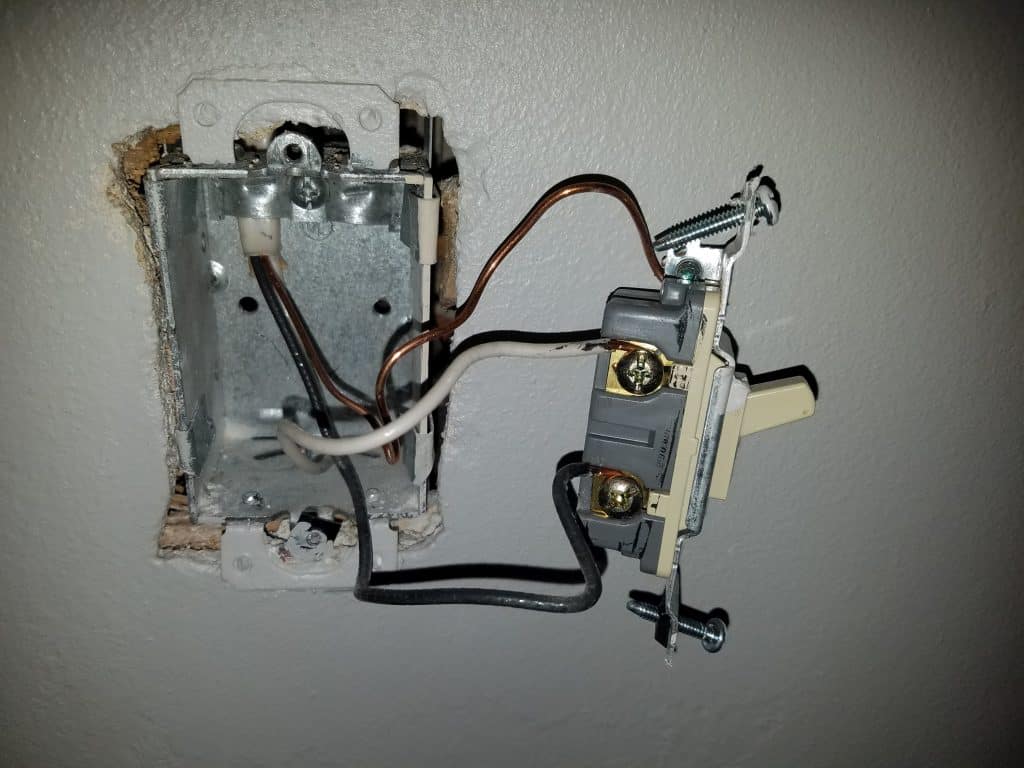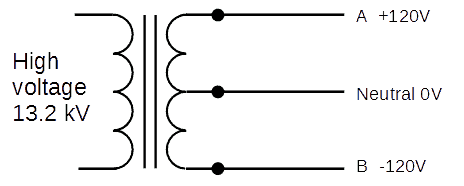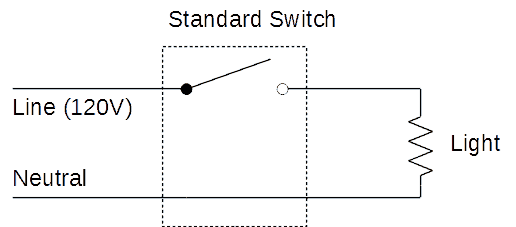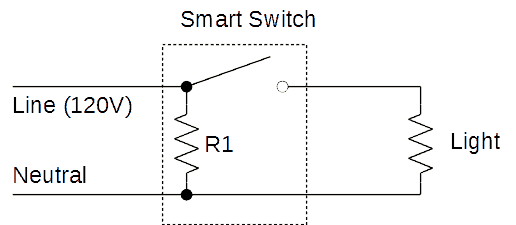Lutron Bathroom Fan Timer Switch
My house was built in 1909. It still has pieces of the original knob and tube electrical wiring nailed to the floor joists in the basement.
Thankfully, the electrical has been updated since then.
Unfortunately, I still have a few switch boxes that don't have a neutral. That means that the vast majority of available smart switches won't work in those boxes. However, I scoured the internet and found some that will.
- What are the best smart switches that work without a neutral?
- How do you know if you don't have a neutral?
- Four ways to fix the "no neutral" problem
- What is a neutral wire?
- What does it mean when a switch has no neutral?
- Final Thoughts
Product prices and availability are accurate as of the date/time indicated and are subject to change. Any price and availability information displayed on [relevant Amazon Site(s), as applicable] at the time of purchase will apply to the purchase of this product.
Prices pulled from the Amazon Product Advertising API on:
What are the best smart switches that work without a neutral?
Here are my two main requirements for a no neutral smart switch:
- Works with no neutral – Well, duh.
- Works with LEDs – Any smart switch I install needs to work with LED bulbs. I quit buying incandescent bulbs years ago.
Believe it or not that narrows down the field quite a bit. There are a few other smart dimmers that work with no neutral, but I didn't list because they don't work with LED lights.
Lutron Caseta Dimmer Switch
Prices pulled from the Amazon Product Advertising API on:
Product prices and availability are accurate as of the date/time indicated and are subject to change. Any price and availability information displayed on [relevant Amazon Site(s), as applicable] at the time of purchase will apply to the purchase of this product.
If reliability is what you're looking for, then look no further. I've been using Lutron switches for over two years, and I don't remember a single time when I pressed the button and the light didn't come on. I've tested a number of other smart switches, and Lutron is the only one that has NEVER failed me.
The dimming performance is also exceptional. Even with LED bulbs (must be marked as dimmable), the lights can be dimmed to almost nothing.
However, the Lutron switches will be the most expensive of the group. If you haven't bought any Lutron products before, the best way to save a little money is to buy a starter kit bundle.
Also, make sure you get the Lutron dimmer switch. The standard Lutron on/off switch will NOT work without a neutral.
Read more: Lutron Caseta Review
Inovelli Red Z-Wave Dimmer Switch
Inovelli Red Series Dimmer Switch
- Uses Z-Wave wireless
- Color LED can be used for smart notifications
- Use with your hub to control scenes or trigger automations
- Use smart mode to control smart bulbs
Prices pulled from the Amazon Product Advertising API on:
Product prices and availability are accurate as of the date/time indicated and are subject to change. Any price and availability information displayed on [relevant Amazon Site(s), as applicable] at the time of purchase will apply to the purchase of this product.
If you are a die-hard home automation geek, this is the switch you want.
This switch is packed with features. You can control multiple scenes, smart bulbs, and even setup smart notifications using the onboard LED. The setup takes quite a bit more work than the Lutron or C by GE systems, but these Inovelli switches are way more powerful from a home automation standpoint.
Just like Lutron, make sure you get the dimmer switch since the on/off switch will NOT work with no neutral.
NOTE: These do require an extra part (Aeotec Bypass) if you use them with no neutral and the load is less than 25W. Most single LED bulbs are under this threshold. If there are multiple bulbs in the fixture, the total load is the sum of the load of all bulbs.
Read more: Inovelli Red Series Review
C by GE 3-Wire Switches

C by GE 3-Wire Smart Dimmer Switch
- Easy setup - No hub required
- Low power light adapter included
- Works with C by GE smart bulbs for color lighting
- Optional motion activated switch also availble
Prices pulled from the Amazon Product Advertising API on:
Product prices and availability are accurate as of the date/time indicated and are subject to change. Any price and availability information displayed on [relevant Amazon Site(s), as applicable] at the time of purchase will apply to the purchase of this product.
The C by GE switches are a great all around option. They are easier to setup than Inovelli and cost less than Lutron.
They connect directly to your WiFi router so there's no need for an additional hub. In addition, you have the option to install C by GE smart bulbs in your fixture to add color lighting to your system.
You can choose from an on/off switch, a dimmer switch, and even a motion-activated dimmer switch (make sure you get the switches labeled "3-wire switches" – not "4-wire").
Each switch comes with an bypass adapter for low power bulbs, which is both convenient and cost-saving. It simply screws into the socket before the bulb. The only negative is that it adds an extra inch or two of length to the bulb which could cause problems in an enclosed area.
The C by GE switches will integrate easily with Google or Alexa, but they currently don't play nice with more advanced hubs like SmartThings or Hubitat.
Read more: C by GE Review
Shelly 1 Relay

Shelly 1 Relay
- For no neutral, install behind load (light fixture)
- Uses WiFi - no additional hub required
- Keep your existing switches
- No bypass needed
Prices pulled from the Amazon Product Advertising API on:
Product prices and availability are accurate as of the date/time indicated and are subject to change. Any price and availability information displayed on [relevant Amazon Site(s), as applicable] at the time of purchase will apply to the purchase of this product.
This solution is a bit different than the other options, but can work just as well. In fact, for many people I think this may be the best solution.
Here's how it works:
If you don't have a neutral at the switch, then you will have a neutral at the load (light fixture).
Therefore, you install the Shelly 1 relay behind the light fixture where there is a neutral.
You keep your existing switch(es).
Since the Shelly is installed with a neutral, you don't need to worry about needing a bypass for small loads.
The Shelly products are WiFi so you won't need another hub. You can choose to use them with cloud integrations or without (local control only). Additionally, the Shelly app is quite versatile. You can set the relay to work with an existing toggle switch, momentary switch, or even 3-way switches. And if the Shelly app isn't good enough for you, you can go "full geek" and install custom firmware.
Of course, Shelly is not the only brand that makes mini smart relays like this. The truth is I haven't tested any others because I have no need. The Shelly products are so versatile, reliable, and reasonably priced that I have no reason to try anything else.
How do you know if you don't have a neutral?
Here's an easy way to check:
If you open your switch box and you see two white wires joined with a wire nut (not connected to the switch), you can be fairly sure your switch has a neutral wire. You should be able to install any smart switch.
A switch box with no neutral loop will usually only have three wires (see image below). Two of the wires will be the current carrying wires that power the light. They will usually be colored one black and one white (potentially with black stripe or marked with black electrical tape). The third wire should be the ground wire and is usually colored green or bare wire.

Four ways to fix the "no neutral" problem
If you want smart control of your lighting, and your home has switch boxes with no neutral, you have 4 options:
1. Buy a smart switch that works with no neutral
When smart switches first came out, it was hard to find a good "no neutral" switch. But manufacturers responded to demand, and now there's a handful of good ones available. Between the three listed (Lutron, Inovelli, and C by GE) in this article, you should be able to find one that fits your needs.
2. Install a smart relay switch at the light fixture
In any installation, either the light switch or the light fixture MUST have a neutral wire. Therefore, if there's no neutral in your switch box, the light fixture will have one.
There are several compact smart switches which can fit inside electrical boxes and light fixtures. So, if you don't have a neutral at the switch, you can use one of these compact smart switches installed at the light fixture.
With one of these smart switches, the existing switch does not need to be changed and will continue to work.
I've used the Shelly relays and they work really well.
3. Buy smart bulbs instead
You don't necessarily need to buy a smart switch. Instead, you could buy a smart bulb.
Most home automation experts recommend smart switches over smart bulbs. But, if you want easy installation and the option for colored lights, buying bulbs could be better.
However, that introduces the new problem of figuring out what to do with the existing switch (here's some ways to solve it). When someone decides to use the wall switch to shut the light off, the power to the bulb is cut, which means it will stop being a smart bulb until you turn the switch back on.
4. Add a neutral by pulling new wires
A neutral wire can be added by pulling an additional conducting wire between the fixture and the switch. This option is probably the most work and most unnecessary.
It can be done, but pulling wires through finished walls can be a real pain, especially if you don't have the proper tools. Sometimes it might even require cutting into drywall, which then needs to be patched and painted. You could certainly hire an expert to get the job done, but it will cost you.
What is a neutral wire?
If you're going to be installing your own smart switches, you will be working with some potentially dangerous wires, so it's probably a good idea to know what you're dealing with so you can avoid making a stupid mistake.
In order to fully understand what a neutral wire is and why we have it, you need to have a basic knowledge of how our homes are wired.
Typical electrical transmission lines in the United States have high voltage electricity (13.2 kV which equals 13,200V!). Before the electricity can be used in your home, it needs to be converted to a lower voltage. This is done using a device called a transformer (represented by the squiggly lines in the image below).

NOTE: Alternating current (AC) does not have polarity. Instead, it has phases. I used the + and – symbols to represent the different phases.
The transformer converts the incoming 13.2 kV electricity down to a usable 240V. Notice that the voltage difference from end A (+120V) to end B (-120V) of the transformer is a total of 240V.
Also notice the transformer has a line coming from the center which has a voltage of 0V. This is the neutral. Since the neutral has a voltage potential of 0, it is significantly safer to work with than the "hot" wires A and B.
Looking at the diagram above, you should be able to see there are three ways to create a circuit:
- Connect A to neutral = 120V
- Connect B to neutral = 120V
- Connect A to B = 240V
Most wiring in your home is 120V (either 1 or 2). Certain applications that require a lot of power, such as a stove, are usually wired for 240V (3).
What does it mean when a switch has no neutral?
According to the previous section, every 120V circuit in your home has both a hot wire (A or B) and a neutral wire. So, how can it be that some switches "don't have a neutral"?
To HAVE a neutral, we want the line voltage to come to our switch box first. Then, from the switch box another loop goes out to the load (light bulb or whatever). The diagram below shows this configuration (this circuit HAS a neutral).

The case that everyone refers to when they say "no neutral" is when the line voltage comes to the light bulb first. Then, from the light bulb, another loop goes to the switch. This is shown in the diagram below.

Both circuits work just fine when you only have a standard mechanical switch. However, you run into a problem when you have a smart switch.
Why is no neutral a problem for smart switches?
In the diagrams below, the dotted rectangle represents a smart switch. R1 represents the load required to power the smart switch. That means there needs to be power running through R1 at all times. Otherwise, the smart switch will be unable to power it's wireless communication.
Smart switch with neutral
Below is a diagram of a smart switch installed in the first configuration (with neutral). Notice that regardless of whether the switch is on or off, there is a clear path from line to neutral that includes R1.

Smart switch with no neutral
Now let's take a look at the second configuration (no neutral) with a smart switch installed.

Again, regardless of whether the switch is on or off, there is a clear path from line to neutral that includes R1. However, in this case the light needs to be included in that path. That's not good because we need R1 to be on all the time but we don't want the light to be on all the time.
The key to creating a smart switch that works without the neutral loop is to make R1 the perfect resistance. R1 needs to restrict the current enough so that the light bulb doesn't turn on when the switch is off. At the same time, it needs to let enough current through so that the switch can power itself.
If it were as simple as making R1 the correct resistance to make sure the light can't turn on when the switch is off, it would be a fairly simple problem to solve. However, due to complexities caused by AC power, it's not a simple problem to solve when it comes to powering LED bulbs. That's why the options are so limited for smart switches that work with no neutral.
Final Thoughts
If you have switch boxes without a neutral wire, there's no need to panic. Several manufacturers have come up with smart switches that solve the problem. And, if none of those are what you're looking for, there's always smart bulbs.
Lutron Bathroom Fan Timer Switch
Source: https://thesmartcave.com/smart-switch-with-no-neutral/


Tidak ada komentar: